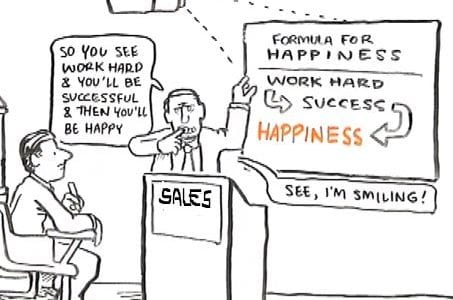by Dan Rockwell – August 2013
The way you deal with today’s frustration reflects the leader or the salesperson you’ll become tomorrow.
Frustration is an alarm clock; a spotlight pointing: a match burned too long.
Frustration is a gift that says pay attention.
Don’t get frustrated with frustration. Frustration is feedback on decisions and relationships.
Frustration’s goal
The singular message of frustration is change.
- Usually it’s you.
- Sometimes it’s others.
- Perhaps it’s processes and procedures.
Repeated frustration
Frustrations that return want attention like neglected children.
Ignoring frustration makes frustration mad.
Successful people choose responses. The weak react.
Choose
[dropshadowbox align=”right” effect=”lifted-both” width=”250px” height=”” background_color=”#ffffff” border_width=”1″ border_color=”#dddddd” ]

“Frustration, like nerves, can either benefit or tear down. I tell our salespeople that the only person frustration hurts is yourself–it’s all internal, not external. The opportunity is still there to find out what others need or want and to find solutions.” [/dropshadowbox]Choose who to be:
[/dropshadowbox]Choose who to be:
- Welcoming. Open up don’t close down. “Come in, let’s talk.”
- Calm. Cool down don’t heat up. Nothing says confidence more than calmness during frustration.
- Able. Assume a do-something posture.
Bonus: Optimistic. Express optimism while acknowledging realities.
Choose what to do:
- Acknowledge don’t ignore. “That’s frustrating,” is better than, “It’s not that bad.”
- Run toward not away. Deal with it now or you’ll deal with it later. Curiosity coupled with courage expands leadership and productivity.
- Stay focused not distracted. Frustrations that distract from the big picture grow larger than they are.
Bonus: Involve others. Don’t act alone. “What can ‘we’ do,” is better than, “What can ‘I’ do.”
Three warnings
- Frustration in one area tends to bleed into others.
- Don’t let short-term frustrations make long-term decisions.
- Frustration’s biggest danger is its ability to create imbalance.
Rudyard Kipling wrote:
If you can keep your head when all about you
Are losing theirs and blaming it on you,
If you can trust yourself when all men doubt you,
But make allowance for their doubting too;
…
Yours is the Earth and everything that’s in it …
How do you deal with frustration?



 I can’t help but think back to some of the best sales people I’ve worked with and their attitude – pretty positive. I also can’t help but think of the people I’ve let go in the past year, all very pessimistic. Another interesting angle to look at would be the affect an optimistic person has on a potential client. Essentially, people like to buy from people they like and people like positive and friendly people. ~
I can’t help but think back to some of the best sales people I’ve worked with and their attitude – pretty positive. I also can’t help but think of the people I’ve let go in the past year, all very pessimistic. Another interesting angle to look at would be the affect an optimistic person has on a potential client. Essentially, people like to buy from people they like and people like positive and friendly people. ~ 

